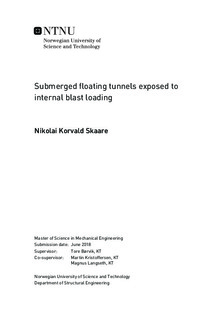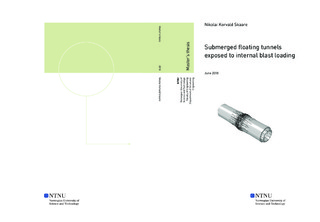| dc.description.abstract | In June 2017, the Norwegian parliament approved the plan of developing the E39 as an improved and continuous Coastal Highway Route between Kristiansand and Trondheim. The goal is to eliminate all ferry connections along the route and cut the current travel time by half. This includes long crossings over deep fjords, and unconventional methods are necessary to achieve this. One of the suggested alternatives is to use a Submerged Floating Tunnel (SFT). If the SFT were to be subjected to an internal explosion, either by accident or an intentional terrorist attack, it could have devastating consequences. Concrete is likely to be the main building material, owing to its low cost and versatility. It is therefore of interest to perform a small scale experimental study and numerical simulations to assess the potential and limitations of finite element programs in simulating concrete structures subjected to internal blast loading.
The main part of the experimental study in this thesis involved performing explosion tests on three different kind of concrete pipes; a total of 18 pipes were tested, 6 of each kind. The different pipes were the BASAL Mufferør ig, unreinforced, and the BASAL Falsrør ig, both reinforced and unreinforced. Dimensions of the pipes were 1500 mm in length, 200 mm inner diameter; and 2250 mm in length, 400 mm inner diameter, respectively. They were exposed to blast loading from centrically placed spherical C4 charges of varying size. For the smaller pipes a charge of 14 g was able to breach the pipe wall. The larger plain concrete pipes got through-thickness cracks at a charge size of 65 g and was split in two. In the case of the larger reinforced pipes, it was necessary with a charge of 300 g to create through-thickness cracks. At 500 g, the pipe wall was breached and large fragments were blown off.
For the numerical study of the pipes, the finite element analysis (FEA) software ABAQUS/Explicit was utilized. To model the concrete the implemented Concrete Damaged Plasticity (CDP) model was used. Initially, to model the pressure loading from the blast, the CONWEP model in ABAQUS was employed. A parametric sensitivity study on the larger plain concrete and reinforced pipes was performed. In general, the plain concrete pipes saw excessive erosion in the center part of the pipe, while the behavior of the reinforced pipes was well reproduced. Additionally, it was also seen that the CONWEP model was not able to take into consideration the reflections of shock waves due to confinement. This gave an underestimation of the pressure applied to the pipe, especially farther out from the center. Lastly, Eulerian analyses in Europlexus was conducted, to investigate potential improvements in describing the pressure loading. More complex effects were captured by this method, but the pressure was still underestimated. | en |

